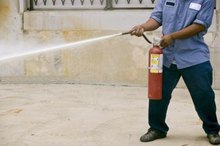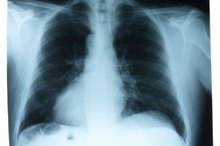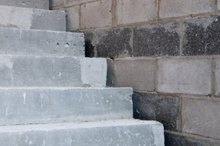Health Hazards in the Powder Coating Process
Powder coating refers to a system for applying paint to a surface by using dry paint. The dry paint is in the form of a powder, which you may spray on the surface. The two major types of powder for powder coating are thermoplastic powders and thermosetting powders. The powder coating process involves some safety hazards, which you can minimize by observing safety measures 4.
Fire Hazards
One of the hazards of the powder coating process is the inherent risk of fires from several ignition sources. Some of these sources include electrostatic discharges, sparks and hot surfaces. The fire could be the result of contact between deposited powder and these ignition sources. Some of the measures for preventing fires during the powder coating process include eliminating all potential sources of sparks or ignition like cigarettes, matches and lighters.
- One of the hazards of the powder coating process is the inherent risk of fires from several ignition sources.
- Some of the measures for preventing fires during the powder coating process include eliminating all potential sources of sparks or ignition like cigarettes, matches and lighters.
Electrical Hazards
Health Risks of Exposure to Fire Extinguisher Chemicals
Learn More
Electrical hazards in the powder coating process are mainly from defective grounding systems that could lead to electric shocks and overheating of the powder coating equipment. To prevent this, test the equipment regularly to ensure it is working properly. Install warning systems or automatic cutouts to help monitor the grounding system. Powder coating operators must wear noninsulating gloves, antistatic overalls and antistatic footwear as preventive measures.
- Electrical hazards in the powder coating process are mainly from defective grounding systems that could lead to electric shocks and overheating of the powder coating equipment.
- Install warning systems or automatic cutouts to help monitor the grounding system.
Health Hazards
Powder coating health hazards arise from the powder's toxic content 2. Some of the toxic substances contained in the powder include lead and other carcinogens. Inhaling the dust can lead to respiratory disorders. The powder also causes irritation when it comes into contact with the skin. Preventive measures include wearing protective clothing like gloves and antistatic overalls that prevent the powder from reaching the skin and having appropriate respiratory equipment available. Another preventive measure is to provide proper ventilation and working exhaust fans in areas where powder coating is carried out.
- Powder coating health hazards arise from the powder's toxic content 2.
- Preventive measures include wearing protective clothing like gloves and antistatic overalls that prevent the powder from reaching the skin and having appropriate respiratory equipment available.
Compressed Air
OSHA Regulations: Wearing Shorts & Long Pants in Construction
Learn More
Compressed air used to apply the dry powder to surfaces poses significant hazards. Compressed air can cause internal injury if it enters the body through the mouth or any other orifice. If you apply compressed air directly to the skin, it can penetrate and cause embolisms. Compressed air could also convey particles that could damage the eye. Preventive measures include maintaining the pressure system and also carrying out periodic inspections. The operators also have to undergo proper training on how to handle the equipment.
- Compressed air used to apply the dry powder to surfaces poses significant hazards.
- Compressed air could also convey particles that could damage the eye.








